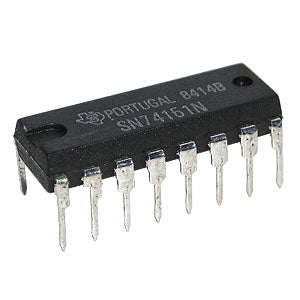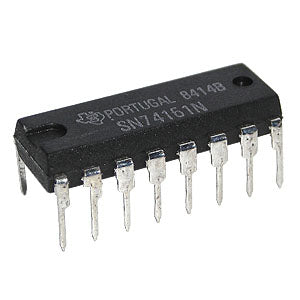Skip to product information
These counters are fully programmable; that is, the outputs may be preset to either level. As presetting is synchronous, setting up a low level at the load input disables the counter and causes the outputs to agree with the setup data after the next clock pulse regardless of the levels of the enable inputs. Low-to-high transitions at the load input should be avoided when the clock is low if the enable inputs are high at or before the transition. The clear function is asynchronous and a low level at the clear input sets all four of the flip-flop outputs low regardless of the levels of clock, load, or enable inputs.
The carry look-ahead circuitry provides for cascading counters for n-bit synchronous applications without additional gating. Instrumental in accomplishing this function are two count-enable inputs and a ripple carry output. Both count-enable inputs (P and T) must be high to count, and input T is fed forward to enable the ripple carry output. The ripple carry output thus enabled will produce a high-level output pulse with a duration approximately equal to the high-level portion of the QA output. This high-level overflow ripple carry pulse can be used to enable successive cascaded stages. High-to-low level transitions at the enable P or T inputs should occur only when the clock input is high.
Features:
Internal Look-Ahead for Fast Counting
Carry Output for n-Bit Cascading
Synchronous Counting
Synchronously Programmable
Load Control Line
Diode-Clamped Inputs
Datasheet Available:Texas Instruments SN74161N
16 pin DIP. Manufactured by Texas Instruments.
A10920
A10920 - SN74161N Synchronous 4-Bit Counter (TI)
Detailed Description
These synchronous, presettable counters feature an internal carry look-ahead for application in high-speed counting designs. The SN74161N is a 4-bit binary counter. Synchronous operation is provided by having all flip-flops clocked simultaneously so that the outputs change coincident with each other when so instructed by the count-enable inputs and internal gating. This mode of operation eliminates the output counting spikes that are normally associated with asynchronous (ripple clock) counters, however counting spikes may occur on the (RCO) ripple carry output. A buffered clock input triggers the four flip-flops on the rising edge of the clock input waveform.These counters are fully programmable; that is, the outputs may be preset to either level. As presetting is synchronous, setting up a low level at the load input disables the counter and causes the outputs to agree with the setup data after the next clock pulse regardless of the levels of the enable inputs. Low-to-high transitions at the load input should be avoided when the clock is low if the enable inputs are high at or before the transition. The clear function is asynchronous and a low level at the clear input sets all four of the flip-flop outputs low regardless of the levels of clock, load, or enable inputs.
The carry look-ahead circuitry provides for cascading counters for n-bit synchronous applications without additional gating. Instrumental in accomplishing this function are two count-enable inputs and a ripple carry output. Both count-enable inputs (P and T) must be high to count, and input T is fed forward to enable the ripple carry output. The ripple carry output thus enabled will produce a high-level output pulse with a duration approximately equal to the high-level portion of the QA output. This high-level overflow ripple carry pulse can be used to enable successive cascaded stages. High-to-low level transitions at the enable P or T inputs should occur only when the clock input is high.
Features:
Internal Look-Ahead for Fast Counting
Carry Output for n-Bit Cascading
Synchronous Counting
Synchronously Programmable
Load Control Line
Diode-Clamped Inputs
Datasheet Available:Texas Instruments SN74161N
16 pin DIP. Manufactured by Texas Instruments.
A10920
![]() WARNING: This product can expose you to chemicals including lead, which is known to the State of California to cause cancer. For more information, go to www.P65Warnings.ca.gov - Why is this here?
WARNING: This product can expose you to chemicals including lead, which is known to the State of California to cause cancer. For more information, go to www.P65Warnings.ca.gov - Why is this here?




